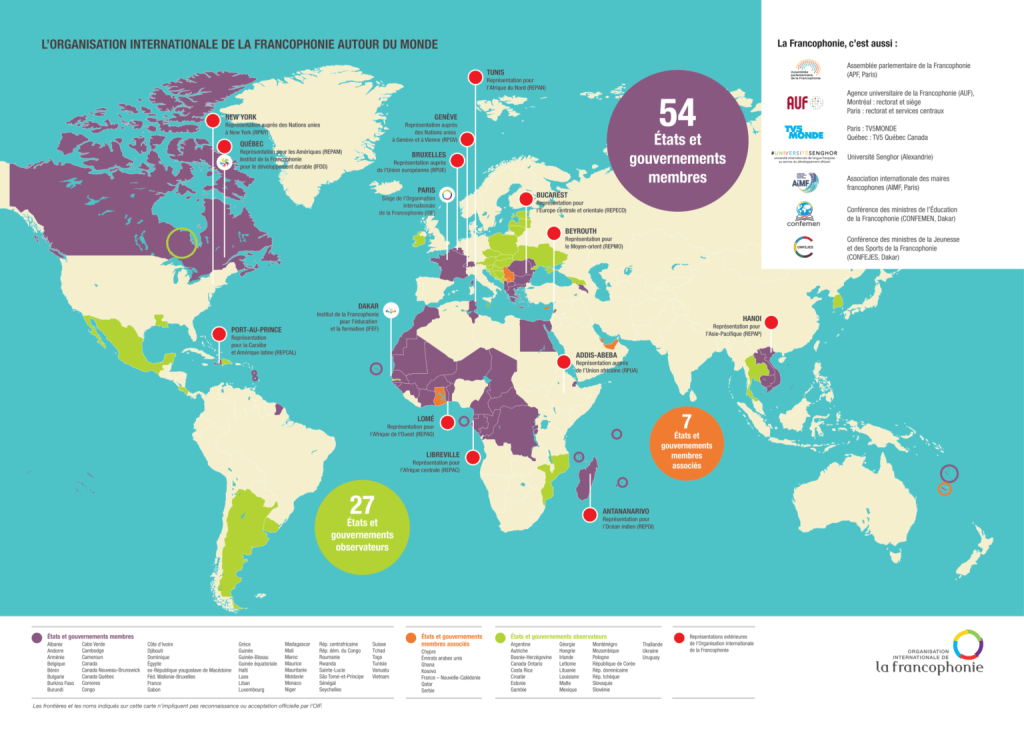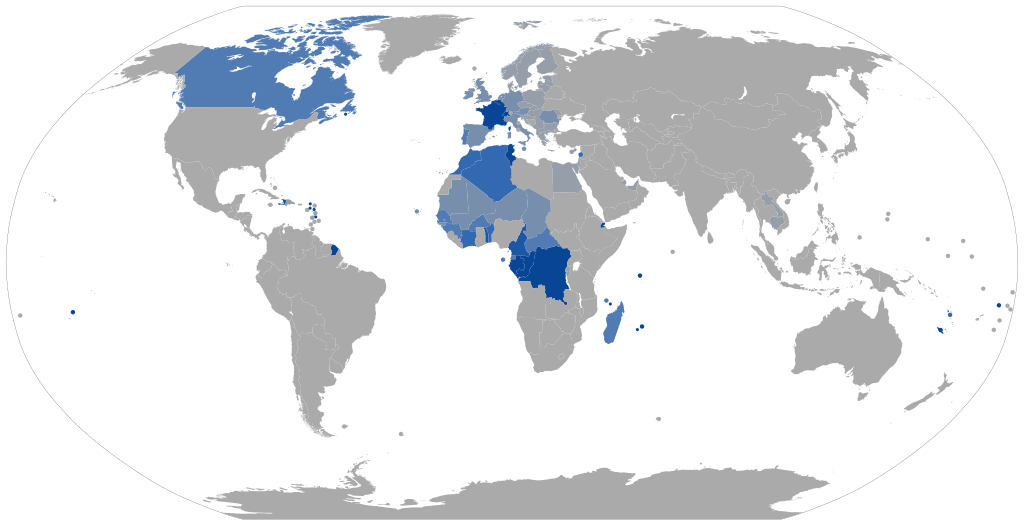French is a Romance language of the Indo-European family, like Spanish, Italian, Portuguese, Romanian and other less spoken languages. It is related to Latin language spoken in Northern Gaul (today France and Belgium). It spread in Europe by replacing languages spoken in France, Switzerland, Italy, notably by becoming the official language of France by the Ordinance of Villers-Cotterêts in 1539, which called for the use of French in all legal acts, notarized contracts and official legislation. This early recognition it led to the standardization of the language, the writing of grammars and dictionaries and the creation of the Académie Française (1635).
French spread around Mediterranean through trade with the port of Marseille in Ottoman empire (present day Turkey, Lebanon, Egypt) where it keeps important positions in education and trade.
The first French colonial empire (XVIth Century to 1763) introduced the usage of French (and subsequent Creole) in most West Indian islands, south Indian ocean, Canada and Louisiane as well as trade posts in India. French was used preferably to other languages to redact diplomatic treaties as its early standardization made it clearer, and less prone to interpretation. It was also the lingua franca of European aristocracy mainly up to 1914.
The second French colonial empire (with the conquest of Algeria in 1830 and most independences from 1960 to 1962) and the Belgian colonization of Congo, Rwanda and Burundi generalized the use of French in most west African countries (for official, business, medias and education use, along with many African languages), and in the Pacific, Madagascar and Indochina. French also became an important language in Israel due to migrations from northern African countries and Balkans.
The Organisation internationale de la Francophonie, which gathers 88 countries reflects the influence of the French language, even if some countries have only a residual number of French speakers. It is the official language of 29 countries (8 autonomous territories and some federal self-governed entities), with a population of over 500 million inhabitants, but is also of widespread use in country where it does not enjoy an official status such as Mauritius, Algeria, Morocco, Lebanon…
The number of French speakers was estimated at 321 million in 2022 and should reach 650 to 700 million in 2050, 80% in Africa.
French has a long history as an international language of literature and scientific standards and is a primary or second language of 36 international organizations including the United Nations, the European Union, the North Atlantic Treaty Organization, the World Trade Organization, the International Olympic Committee, and the International Committee of the Red Cross.
Some reasons to learn French
The knowledge of French is developing in South Asia and peculiarly India, due to the development of trade with Europe, West Africa and South Indian Ocean islands. In Bangladesh, the important participation of the country to United Nations missions, emigration to Canada and Europe, opportunities of studies are the main motivations behind the increase of demand for French courses. Traditionally, French was taught in upper-class frequented private schools where teaching was in English as a foreign language, in order to open careers opportunity.

Source : Organisation international de la Francophonie.

Source : Wikipedia – French speakers (dark blue : mother tongue /middle blue: official language (education, business, administration) / light blue : widespread use).
French is an Indo-european language and thus shares some parenthood with Bengali language, and much more with English (30% of English words come from French directly and many more from Latin and other romance languages).
French is taught in the Alliance françaises of Dhaka and Chittagong, in the institute of Modern Languages of the Universities of Chittagong and Dhaka, some other universities and departments around the country, and in some English-programme middle schools.
Since the early 2000s, the teaching of French has been structured along the guidelines of the Common European Framework of Reference for Languages of the Council of Europe.
The traditional distinction between Beginner, Intermediate and Advanced, has been defined and described for each activity: reception (listening and reading), production (spoken and written), interaction (spoken and written) and mediation (translating and interpreting).
| Level group | Level | Description |
| A Basic user | A1 Breakthrough | Can understand and use familiar everyday expressions and very basic phrases aimed at the satisfaction of needs of a concrete type.Can introduce themselves and others and can ask and answer questions about personal details such as where they live, people they know and things they have.Can interact in a simple way provided the other person talks slowly and clearly and is prepared to help. |
| A2 Waystage | Can understand sentences and frequently used expressions related to areas of most immediate relevance (e.g. very basic personal and family information, shopping, local geography, employment).Can communicate in simple and routine tasks requiring a simple and direct exchange of information on familiar and routine matters.Can describe in simple terms aspects of their background, immediate environment and matters in areas of immediate need. | |
| B Independent user | B1 Threshold | Can understand the main points of clear standard input on familiar matters regularly encountered in work, school, leisure, etc.Can deal with most situations likely to arise while travelling in an area where the language is spoken.Can produce simple connected text on topics that are familiar or of personal interest.Can describe experiences and events, dreams, hopes and ambitions and briefly give reasons and explanations for opinions and plans. |
| B2 Vantage | Can understand the main ideas of complex text on both concrete and abstract topics, including technical discussions in their field of specialisation.Can interact with a degree of fluency and spontaneity that makes regular interaction with native speakers quite possible without strain for either party.Can produce clear, detailed text on a wide range of subjects and explain a viewpoint on a topical issue giving the advantages and disadvantages of various options. | |
| C Proficient user | C1 Advanced | Can understand a wide range of demanding, longer clauses and recognise implicit meaning.Can express ideas fluently and spontaneously without much obvious searching for expressions.Can use language flexibly and effectively for social, academic and professional purposes.Can produce clear, well-structured, detailed text on complex subjects, showing controlled use of organisational patterns, connectors and cohesive devices. |
| C2 Mastery | Can understand with ease virtually everything heard or read.Can summarise information from different spoken and written sources, reconstructing arguments and accounts in a coherent presentation.Can express themselves spontaneously, very fluently and precisely, differentiating finer shades of meaning even in the most complex situations. |
The offer of the Alliance française of Chittagong reflects this scheme.
The A1 and A2 are offered in 120 hours in extensive courses, B1 and B2, each with respectively 300 and 240 hours.
The various goals of students correspond to various levels:
Ouverture